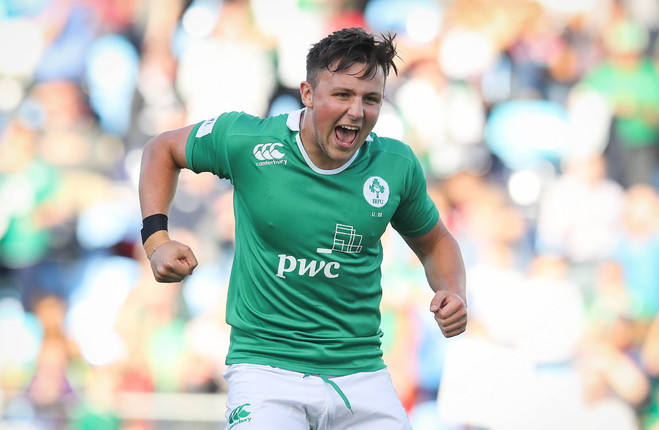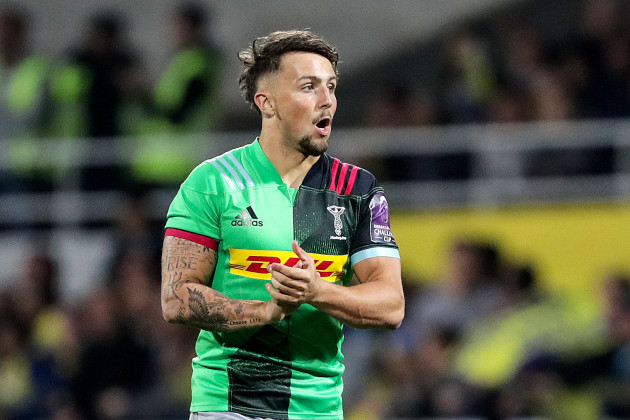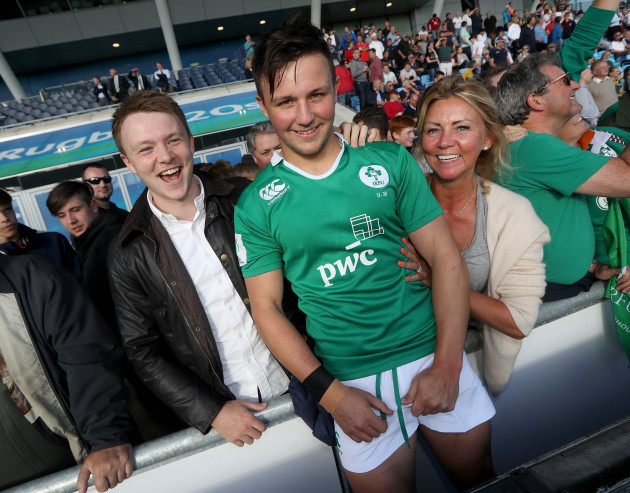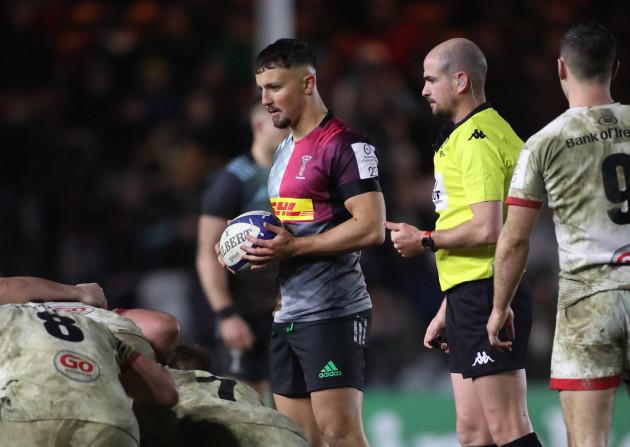ALL THAT REALLY matters is that Niall Saunders feels happy these days. It took retiring from professional rugby at the age of just 22 to make it so.
Playing for his beloved Harlequins and tipped as a future Ireland scrum-half, Saunders had a big career in the game ahead of him. But the game was making him feel imprisoned and deeply unhappy. So he decided to walk away in 2020.
Saunders had already had been forced to quit the sport for several months in 2017 due to a blood disorder – Idiopathic Thrombocytopenic Purpura [ITP] – he has lived with since the age of two. He battled back from that stint to return to the Harlequins squad and was playing Premiership and Champions Cup rugby as recently as March 2020.
So when Quins confirmed that Saunders was retiring from rugby two summers ago, many people presumed that it was due to his blood disorder. It wasn’t that simple. The truth is that Saunders was miserable and needed to get out of the game for his own good.
“I had been going through a patch of two years where I wasn’t enjoying rugby but it wasn’t just the rugby specifically, more the lifestyle that came with it,” explains Saunders, who turned 24 last month.
“I just felt pretty trapped. I felt so restricted as a person and there was a different life I wanted to live.”
The unhappiness was spilling into the rest of Saunders’ life. He would get angry with family and friends over nothing. He was acting selfishly. He started living for the weekend, when he could go out and get drunk, fleetingly forgetting about the pressures he felt in his career. He was racking up big bills in a bid to blank it all out.
“I went to Barcelona for a weekend with a mate and spent €2,500. That was the kind of release I was living for,” he says.
When Covid came into the world in 2020, the scrum-half felt like it was his opportunity to escape.
Saunders still had two years left on his contract with Quins at the time. The club rated him highly and wanted him to play on, but once he explained the depth of his unhappiness to then-head coach Paul Gustard, they were good to him.
Saunders’ deal was terminated and he disappeared for seven months to Brazil, Mexico, Costa Rica, Nicaragua – wherever wasn’t locked down amidst the pandemic and would take him and his friends. All of a sudden, he was just Niall Saunders, a young man travelling the world. Not Niall Saunders, the rugby player.
“It’s one of the most important things I’ve done in my life,” he says. “I’m almost speechless now because I loved it so much…
“I was just happy, you know?”
Saunders didn’t play any rugby for nearly two years after the retirement but has returned more recently, featuring for the Tel Aviv Heat last month in the Rugby Europe Super Cup. He has now signed up with the Utah Warriors in Major League Rugby [MLR] for the 2022 season.
It’s not a return to the pro game he left behind in 2020. MLR contracts last for only six months, so Saunders can head away travelling or working for the other six months of the next year. The standard is obviously lower than the Premiership, with much less pressure. These are tentative steps back into the sport with the aim of simply enjoying himself.
But let’s go back to the start. All the strands are important in Niall Saunders’ story.
His dad is Rob Saunders, who famously captained Ireland on his debut and won a total of 12 caps at scrum-half, featuring at the 1991 World Cup.
Niall was born in Surrey, where his family had settled and it’s no surprise the house was rugby-mad. His brother also plays, while his sister and mum always proudly supported.
A scrum-half like his dad, Niall rose through the ranks at renowned rugby school Epsom College, first linked up with Quins at the age of 12, and came into the Ireland system through the Exiles to wear green at U18, U19, and U20 levels.
His father was brilliant for advice and support and Niall would joke about winning 13 Ireland caps when he was a pro, but the fact that Rob had been such a good player also added a little self-imposed pressure in his son’s head.
“Rob playing for Ireland, me being a young nine, playing for Ireland at 18s, 19s, 20s, there was kind of this pathway set out for me and I felt like I was obliged to walk down it. All my family, everyone who knew me, my identity was as a rugby player.”
Saunders was diagnosed with ITP early on. He describes it as a condition whereby his antibodies – which attack viruses in the body – think his blood platelets are a virus so they attack them too. The average person has somewhere from 150,000 to 400,000 platelets per cubic millimeter in their blood but Saunders was down at 1,000 at times.
“I don’t clot. If I cut, I bleed a lot or if I get hit, I’ll bruise because I have no clotting factors to sort that out,” explains Saunders. “I was pretty much near a hemophiliac.”
It’s a rare condition and doctors initially said he would grow out of it within two years. When that didn’t happen, they advised that he’d grow out of it during puberty, but that didn’t happen either.
While he visited specialists and tried a range of medications to help manage the disorder, Saunders refused to let it stop him chasing his rugby dream. Recovery was naturally a huge focus but he continued to climb the ladder and nearly joined Ulster after playing for the Ireland U19s.
His mother, Jennifer, is from Belfast and his dad grew up there after being born in Nottingham, so Niall went on a visit and stayed with his nan. Ulster introduced him to Ruan Pienaar, he spoke to director of rugby Les Kiss, and was taken to a game at Kingspan Stadium.
Ulster “pushed the boat out” with a good contract offer as they outlined a pathway for Saunders into the senior Ireland team within four or five years. The timing wasn’t right, though, with Saunders’ doctors back in England and also given his ambitions of playing for Quins. It was a “split decision” but he stayed put.
In 2016, Saunders was part of the Ireland U20s team that went all the way to the final of the World Championship under Nigel Carolan. Still just 18 at the time, the clever scrum-half impressed with his obvious potential.
“It was probably my most enjoyable experience playing rugby, purely because the set-up was a load of lads who loved playing rugby and there were no bad people there,” recalls Saunders fondly.
He formally joined Quins on a two-year contract the same summer and the sky looked to be the limit. Unfortunately, Saunders’ blood disorder flared up and meant he went over a year without playing a game after the U20s Championship. He wasn’t allowed to take contact in training for long spells, even against a tackle bag.
As he reflects now, Saunders sees that time as almost being the beginning of the end.
“That period probably tarnished my love of rugby because I wasn’t playing,” says Saunders. “My introduction to professional rugby was just doing shuttles, then going to the gym, becoming so, so fit for no reason.”
His body just wasn’t right. He remembers getting a minor hamstring strain and the entire back of his leg going black with bruising. He was constantly in ice baths.
Physically in major difficulty, it was also affecting Saunders mentally. And so, he asked Quins to terminate his contract towards the end of the 2016/17 season.
“I had to stop,” says Saunders. “I was mentally drained and fed up, just exhausted.
“I was slightly depressed because I had the dream of playing rugby, had come out of the World Cup with huge confidence, and then went straight into an unenjoyable slog.”
Saunders headed away to South East Asia for three months with his friends, clearing his head and completely forgetting about rugby. When he came back, he was determined to get on top of his blood disorder once and for all.
It was a tough period of regular trips to London to see doctors – he has been to 18 different specialists over the course of his life – and trying a wide range of different medications. It was the ninth medication that finally worked.
Some of the docs had told Saunders he would never play rugby again – one said he shouldn’t even ride a bike – but the specialist who cracked it asked him to try a drug called Romiplostim, which he says is usually for cancer patients. Initially, it didn’t work.
“That was the lowest point because that’s when I thought it was all over,” says Saunders. “I had to take so many fucking setbacks. I just wanted to play rugby, there was nothing else I wanted to do.
“But weirdly enough, we tried the drug again at a lower dose and it worked.”
It boosted Saunders’ blood platelet count to a normal range and he resumed training, with Quins welcoming him back and facilitating a dual-registration deal with Championship side Esher. He made his Quins debut in the Anglo-Welsh Cup in November 2017 and then advanced to play for the senior team six times during the 2018/19 season.
And yet, after fighting so hard to keep the dream alive, progressing to his Champions Cup debut in 2019, it didn’t feel right to Saunders. He enjoyed aspects of it – he liked having a good pass, a good kick, being fit and fast and strong. But he came to hate the way rugby had to be his whole life.
“Getting up for training, having to always sleep because you’re knackered, doing two hours of homework on how training went, what the team you’re playing this week’s weaknesses are… that just takes over your life.
“In the Prem, because it’s such a high-pressure situation, with a lot of money in the game, there’s a lot of people expecting a lot of things from you so you owe it to them to do all your homework. That puts a lot of stress and burden on you.
“I was unhappy coming home from training. I wasn’t really telling anyone that I was unhappy, I was bottling it up. I didn’t want people to think I was unhappy because I wasn’t being picked or not playing or anything like that.
“For me, it was just easier to deal with it by myself but in hindsight, it’s so silly to do that. Bottling it up was the worst thing I did.
“It crept into other aspects of my life. I would be quite angry a lot of the time and I’d take it out on my loved ones. I’d just be constantly unhappy and very selfish. I’d make little decisions just for me and not for anyone else.
“That’s not like me and it was a personality change that I could see happening. I would be just waiting for the weekend so I could go on the piss because I’d be looking for that release where I didn’t have to be a rugby player.”
Saunders stresses that he never shied away from hard work. He would be one of the last on the training ground but it had become purely a job for him, rather than the passion it began as. He was going through the motions and knew it was time to pull the plug.
When he did so in 2020, the burden was instantly lifted.
“There was a huge sense of relief. You hear people describing a load being taken off their shoulders and that didn’t ring true to me until I stopped playing. It genuinely felt like I had a whole new lease in life and a different identity.
“I could go and do stuff that I normally couldn’t do playing rugby because I’d have to train the next day.”
He went off travelling and didn’t watch a rugby game for a long time. Saunders does admit there were pangs of doubt.
“It was emotional because I had put all my eggs into this one basket of being a rugby player. I’m quite a competitive person and when I see lads who are playing for Ireland now from my U20s team, it’s hard for me to watch.
“Deep down, I know that if I stuck at it with rugby, I would have played for Ireland. It doesn’t matter who hears that, it’s something I believe deep down. It’s enough for me to know I would have done it.”
He also had to deal with some people who struggled to understand how he could leave behind a rugby career that seemed like a dream to them.
“I had one guy message me on social media saying “You’re a f*cking p*ssy. If I had half the talent you have, I would be happy to play.” He said I was wasting my talent. You see a message like that and just know they don’t know what they’re talking about.
“It wasn’t a decision I made lightly but it’s one that has made me a lot happier as a person.”
When he got back from travelling, Saunders did a course in ‘Teaching English as a Foreign Language’ and was set to head away to Hong Kong to teach and play social rugby, only for the pandemic to cancel those plans.
His dad flagged the existence of the MLR with him and linked him with Mike Friday, who is the USA 7s coach, to discuss rugby in the States.
“My first thought was that it seemed like going back to professional rugby and that wasn’t what I wanted to do. I was scared I would fall straight back into that trap,” says Saunders.
But he liked the sound of six months on, six months off and the prospect of a more relaxed approach to rugby.
“It’s not Premiership standard and I would like to go back at a slightly lower level where rugby isn’t controlling my life, where I’m not constantly under pressure.”
Friday put Saunders in touch with former England wing Tom Varndell, now an agent, and they got a deal at Utah Warriors, who have also signed former Leinster underage out-half and St Mary’s RFC man Mick O’Gara for the 2022 season, which starts in three weeks.
Before departing to the States, Saunders took up a short-term offer from Tel Aviva Heat to get involved in their ambitious plans to bring professional rugby to Israel. Former Harlequins player Demetri Catrakilis is the club’s coach and Saunders’ close friend, Gabriel Ibitoye, another ex-Quins man, was over there.
Saunders joined them last month for three games, his first rugby of any kind since a Premiership appearance against Bristol in March 2020.
“It honestly reignited a lot of the love I had for the game,” says Saunders of the stint with Tel Aviv. “I didn’t realise it was the first professional game ever played in Israel which is quite a cool thing to say you were involved in. It was a huge confidence booster because I didn’t know if I’d be fit, able to pass, able to kick.”
There was some recent interest from a Premiership club but Saunders wasn’t tempted back in. He’s just looking forward to an adventure in Utah and playing rugby to enjoy it.
His health is better than ever. Indeed, once he stopped playing, the blood disorder leveled out and he isn’t currently taking medication, with indications he is in remit. He’s got peace of mind knowing which drug works if things deteriorate again and his doctor is happy for Saunders to play again.
And so Saunders sets off for the US with his family’s love and support behind him.
“A big part of me playing rugby was to make my family proud,” says Saunders. “To turn my back on this pathway that had been set out for me, and which I had been happy to walk down, it was really tough.
“But my family understood that this was the right decision.
“There’s more to life – rugby is just a game, a sport. It’s not worth anything more than what you want to put into it.”





